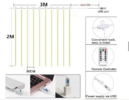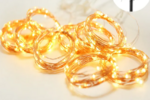Hi all, I posted a while ago about converting my solar lights to mains current, well now that's done I have been having quite a few problems.
Ill try to keep it short - So I wired 7 sets of string lights together (~1000 total leds) in parallel and connected them to a 3v watch battery, all worked well, I needed to do some re-jigging of the led's strings themselves (they are attached to a fence and drooping a bit) after I completed that and connected them to their 3v power supply they no longer worked, I put the ohm meter across the + and - leads and got a reading of about 8ohm, where I should have got open line. So I disconnected all 7, found two sets where showing a short (I suspected I have crossed a wire when re-fixing them), I couldn't for the life of me find the issue on either set and ended up chucking those out and replacing with another two sets , these two new ones were not solar they were wired and both came with a usb power source but they were an identical product to the existing ones.
I decide the included usb power may be better than my 3v buck converter so I wired that usb supply in, and they all worked great. The following night.. no lights. I cut the wires and sure enough I have a short again, I find a bit of cable wedge behind a fence post on one of the led sets as I pull it out it snaps, I measure resistance in both directions and its open, well fantastic, resoldered it and I think I've fixed it. the lights run perfectly for 2 nights on the usb power (its plugged into a powerboard with usb plug upto 2.1 amp supplied)
Well surprise surprise, now guess what, night 3 no lights again, I cut the line close to the power supply, and I'm showing 8ohms of resistance again so another short circuit. I isolated the previously bad set again, that is not showing a short, but I see the short on the other side of the cut where the remaining 6 sets are.
Needless to say I am going a bit insane here, I can understand if I was overvolting/currenting them I would have problems, but its almost the opposite I wasn't sure if the single usb can handle the load but but when they worked they looked good same brightness as they were on solar.
One thing to add is, these led strings have been in place for 2 years, on solar they were running fine every night till the batteries went flat.
Is it possible one of these tiny leds has burned out and created a short? is there any practical way to find that? As it would be very easy to just pull the led off the strand, as once I do find the set with the short ill probably need to bin it and replace it (this might become a daily occurrence). The strings themselves have not been touched between the time they worked and the stime they stopped working.
For info the product are resin dipped led curtain lights -

Ill try to keep it short - So I wired 7 sets of string lights together (~1000 total leds) in parallel and connected them to a 3v watch battery, all worked well, I needed to do some re-jigging of the led's strings themselves (they are attached to a fence and drooping a bit) after I completed that and connected them to their 3v power supply they no longer worked, I put the ohm meter across the + and - leads and got a reading of about 8ohm, where I should have got open line. So I disconnected all 7, found two sets where showing a short (I suspected I have crossed a wire when re-fixing them), I couldn't for the life of me find the issue on either set and ended up chucking those out and replacing with another two sets , these two new ones were not solar they were wired and both came with a usb power source but they were an identical product to the existing ones.
I decide the included usb power may be better than my 3v buck converter so I wired that usb supply in, and they all worked great. The following night.. no lights. I cut the wires and sure enough I have a short again, I find a bit of cable wedge behind a fence post on one of the led sets as I pull it out it snaps, I measure resistance in both directions and its open, well fantastic, resoldered it and I think I've fixed it. the lights run perfectly for 2 nights on the usb power (its plugged into a powerboard with usb plug upto 2.1 amp supplied)
Well surprise surprise, now guess what, night 3 no lights again, I cut the line close to the power supply, and I'm showing 8ohms of resistance again so another short circuit. I isolated the previously bad set again, that is not showing a short, but I see the short on the other side of the cut where the remaining 6 sets are.
Needless to say I am going a bit insane here, I can understand if I was overvolting/currenting them I would have problems, but its almost the opposite I wasn't sure if the single usb can handle the load but but when they worked they looked good same brightness as they were on solar.
One thing to add is, these led strings have been in place for 2 years, on solar they were running fine every night till the batteries went flat.
Is it possible one of these tiny leds has burned out and created a short? is there any practical way to find that? As it would be very easy to just pull the led off the strand, as once I do find the set with the short ill probably need to bin it and replace it (this might become a daily occurrence). The strings themselves have not been touched between the time they worked and the stime they stopped working.
For info the product are resin dipped led curtain lights -


